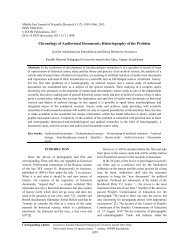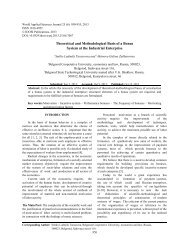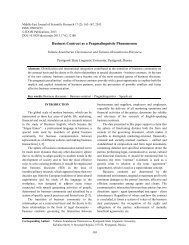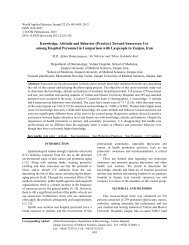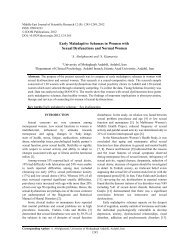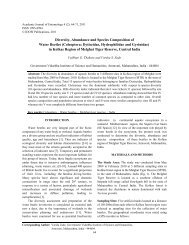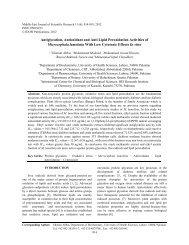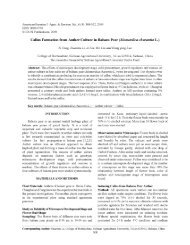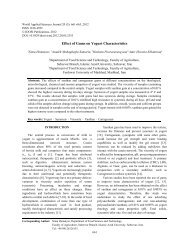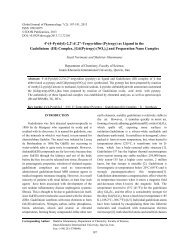You also want an ePaper? Increase the reach of your titles
YUMPU automatically turns print PDFs into web optimized ePapers that Google loves.
Academic Journal of Entomology 5 (1): 37-40, 2012<br />
ISSN 1995-8994<br />
© IDOSI Publications, 2012<br />
DOI: 10.5829/idosi.aje.2012.5.1.6315<br />
Efficacy of Emamectin Benzoate on Tuta absoluta Meyrick<br />
(Lepidoptera: Gelechiidae) Infesting a Protected Tomato Crop in Algeria<br />
Abdelhamid Gacemi and Yamina Guenaoui<br />
Department of Agronomy, University of Abdelhamid Ibn Badis, Mostaganem, Algeria<br />
Abstract: Tuta absoluta Meyrick became the most important pest of tomato crops in Algeria since 2008.<br />
Increasing problems in control of Tuta absoluta necessitate development of an integrated control program<br />
through a combination of preventive methods, biological control and chemical control if needed in order to keep<br />
the population density as low as possible. In the vicinity of Mostaganem, the density of T. absoluta<br />
population’s increase dramatically with 50 to 100% damage to fruit production. When biological control is not<br />
efficient, chemical control can be used with selective pesticides in an integrated strategy. This study is<br />
conducted in order to evaluate the efficacy of Emamectin-benzoate against larvae of the tomato leaf miner. A<br />
field trial was conducted in tomato greenhouse during 2009- 2010. Three foliar applications were made at 7 days<br />
interval in a tomato greenhouse. The results showed a good activity on Tuta absoluta larvae with a mortality<br />
reaching 87%; but it is important to use it with a great attention when native natural enemies are working.<br />
Key words: Tomato Tuta absoluta Emamectin-Benzoate Efficacy Integrated Control<br />
INTRODUCTION<br />
chemical control is the most useful method in combination<br />
with other tactics and strategies of tomato integrated pest<br />
Tomato (Lycopersicon esculentum L.) belonging to management (cultural tactics, mass trapping with sex<br />
Solanaceae and its origin is the Andean zone particularly pheromones, biological control….).<br />
Peru-Ecuador-Bolivian areas [1] but cultivated tomato In Algeria, some bio-pesticides began to be used<br />
originated in Mexico [2].<br />
against this pest. The insecticide ’Emamectin benzoate’ is<br />
It is one of the attain a high and stable growth under a new macrocyclic lactone insecticide derived from the<br />
deficient moisture most popular and versatile vegetable all avermectin family of natural products. These products<br />
over the world. It conditions [3]. Present investigation have been developed for the control of Lepidoptera pests<br />
was undertaken to plays a vital role in providing a on a variety of vegetable crops worldwide [13], with a<br />
substantial quantity of study some of the morphological particular efficacy against T. absoluta. The compound is<br />
parameters, like root and vitamin C and A in human diet not systemic, but it exhibits good translaminar activity<br />
[4-5]. [14].<br />
Tuta absoluta Meyrick (Lepidoptera: Gelechiidae) The present study was carried out to test the efficacy<br />
is a native microlepidopteron of South America [6-7], of Emamectin benzoate against the larval stages of<br />
which can affect all aerial parts of the plant (leaves, T. absoluta in a greenhouse tomato crop.<br />
flowers, stems and fruit). This pest has the potential to<br />
cause damage which can be up to 100% losses [8-9].<br />
MATERIALS AND METHODS<br />
This South American tomato leafminer, T. absoluta,<br />
is one of the major pests of tomato crop since its Plant Cultivars: The variety of tomato planted is Tafna (it<br />
detection in the Mediterranean basin [10]. T. absoluta was is the most used cultivar in the vicinity of Mostaganem<br />
reported for the first time in Algeria in 2008 [10-12]. (Algeria). The tomato crop was conducted in an unheated<br />
It causes extensive damage on tomato in the north where was installed an insect-proof and a sex-pheromonal<br />
western of Algeria. When population explosion occurs trap (Delta) during spring season.<br />
Corresponding Author: A. Gacemi, Department of Agronomy, University of Abdelhamid Ibn Badis, Mostaganem, Algeria.<br />
Tel: +213776202022.<br />
37
Acad. J. Entomol., 5 (1): 37-40, 2012<br />
Fig. 1: Chemical structure of Emamectin- Benzoate [15-16].<br />
Treatment Test: The tested treatments are carried out on<br />
tomato plants in greenhouse, it was divided into four<br />
blocks with five rows/block and five plants/ row. We used<br />
a knapsack sprayer. The used dose of pesticide is<br />
0.6gr/l or (60 gr/h1).<br />
The treatment relates to a row on two in all the blocks,<br />
alternating rows (one treated with the pesticide and<br />
another not treated). Corresponding to 50% of tomato’s<br />
plants is treated and 50% control (Fig.2).<br />
During treatment, plastic sheetings were installed<br />
between rows to avoid contamination of control groups<br />
by the pesticide. Three treatments were applied during<br />
Jun 2010 at 7 days intervals. Ten leaflets/ plant were taken<br />
randomly from 24 plants and observed under a<br />
stereomicroscope in order to evaluate the mortality of<br />
larvae. The observation was performed 2 days after each<br />
treatment [17].<br />
Statistical Analysis: The variances, averages and<br />
standard deviation of various repetitions were<br />
calculated and analyzed by the software of Statistics<br />
(STAT BOX 6.0.4. GRIMMERSOFT) and the device used<br />
are the unifactorial total randomization (one studied<br />
factor) by the test of Newman - Keuls (P 0.05 and P 0.01)<br />
[17].<br />
Fig. 2: Method of treatment of larvae by RESULTS<br />
Emamectin-benzoate in greenhouse.<br />
Emamectin benozate caused an important mortality of<br />
Pesticide: Emamectine-Benzoate is a novel foliar T. absoluta larvae (Figure 03 a dead larva after treatment).<br />
insecticide of Lepidoptera group.It is a derivative of the After observing the samples, we identified the dead<br />
natural Avermectin family produced by fermentation of a larvae and live larvae in the treated group and untreated.<br />
soil micro<strong>org</strong>anism Streptomyces avermitilis [15,16]. Mortality rates were calculated and corrected by the<br />
Emamectin-benzoate had been homologated by the Schneider-Orelli formula:<br />
National Institute of Plant Protection (INPV). It is<br />
Mortality in the treated (%)<br />
registered under the number 06.44.046. It can be an active<br />
- Mortality in the control (%)<br />
ingredient against T. absoluta larvae if farmers<br />
Corrected mortality (%) = 100 − Mortality in the control (%)<br />
understand better its application periods when needed.<br />
Fig. 3: Comparison between treated larva (on the left) and healthy one (on the right)<br />
38
Table 1:<br />
Acad. J. Entomol., 5 (1): 37-40, 2012<br />
Mortality rates of T. absoluta larvae treated by Emamectin-benzoate.<br />
st nd rd<br />
1 Treatment Control 2 Treatment Control 3 Treatment Control<br />
Mortality Rates (%) 84.88 19.53 92.18 21.98 83.18 19.08<br />
Fig. 4: Mortality rates of T. absoluta larvae treated by<br />
Emamectin -benzoate.<br />
Larval population of T.absoluta in the greenhouse<br />
Fig. 5: Estimated larval population of T. absoluta in the<br />
greenhouse before and after treatment.<br />
Lopez et al. [18] obtained a mortality rate of 90% of<br />
larvae on tomato leaves. Jansson et al. [19] reported the<br />
efficiency of the same bio-pesticide on others<br />
lepidopteran pests on the tomato crop such as<br />
Keiferia lycopersicella Walsingham (Lepidoptera:<br />
Gelechiidae).<br />
The efficacy of Emamectin benzoate was reported by<br />
other authors on other pests of different crops like corn<br />
earworm Helicoverpa zea Boddie (Lepidoptera:<br />
Noctuidae) [20] and Cotton leafworm Spodoptera<br />
littoralis Boisd. (Lepidoptera: Noctuidae) [21].<br />
We should be very tactful to avoid the use of this bioinsecticide<br />
by farmers without explaining a good reason<br />
for their action. When natural enemies are involved in the<br />
control of the pest, they have to be careful what they are<br />
doing so that they do not kill it. If they act without<br />
thinking they risk a lot of problems.<br />
The results gave an acceptable efficacy of the<br />
biopesticide Emamectin-benzoate against the tomato<br />
leafminer Tuta absoluta Meyrick (Lepidoptera:<br />
Gelechiidae).<br />
ACKNOWLEDGEMENTS<br />
We would like to thank all those helped us in this<br />
work. Thanks to Mr. K. Aissaoui for the product used in<br />
this study and to the Pr. Rosa Vercher UPV Valencia<br />
(Spain) for traps and pheromones capsules used in<br />
catching Tuta absoluta males.<br />
Fig. 6: Population of males of Tuta absoluta weekly<br />
caught in the sex pheromone trap<br />
Mortality rates were 84.88% in first treatment, 92.18%<br />
in second and 83.18% in third treatment (Fig. 4).<br />
DISCUSSION<br />
The results show a good efficacy of Emamectinbenzoate<br />
against tomato leafminer T. absoluta.<br />
We obtained a mean of 86.7% of mortality (with three<br />
treatments). The persistence of the product according to<br />
the firm can vary between 7 and 14 days. We think that<br />
the number of treatments does not exceed three when<br />
need.<br />
REFERENCES<br />
1. Salunkhe, D.K., B.B. Desai and N.R. Bhat,<br />
1987. Vegetable and flower seed production.<br />
1st. Edn. Agricole pub. Acad. New Delhi, India,<br />
pp: 135.<br />
2. Uddain, J., K.M. Akhter Hossain, M.G. Mostafa<br />
and M.J. Rahman, 2009. Effect of Different Plant<br />
Growth Regulators on Growth and Yield of<br />
Tomato. International J. Sustainable Agriculture,<br />
1(3): 58-63.<br />
3. Nahar, K. and R. Gretzmacher, 2011. Response of<br />
shoot and root development of seven tomato cultivars<br />
in hydrophonic system under water stress. Academic<br />
J. Plant Sci., 4(2): 57-63.<br />
39
Acad. J. Entomol., 5 (1): 37-40, 2012<br />
4. Thompson, H.C. and W.C. Kelly, 1983. Vegetable 9. 14. Willis, G.H. and L.L. McDowell, 1989. Pesticide<br />
Thakur, P.S., 1989. Relationship between Crops, 5th persstence on foliage. Rev. Environ. Contam. Toxicol.<br />
Edn. Tata McGraw Hill Publishing Co. Ltd. proline 100: 23-73.<br />
utilization ability and recovery potential in New Delhi. 15. Schallman, M.D., D. Valentino, M. Nallin and L.<br />
pp: 611. tomato (Lycopersicon esculentum Mill.) Kaplan, 1986. Avermectin ß2<br />
0- Methyltransferase<br />
cultivars.<br />
activity in ‘Streptomyces avermitilis’ mutants that<br />
5. Bose, T.K. and M.G. Som, 1986. Vegetable Crops in produce increased amounts of the avermectnis.<br />
during rehydration. Acta physiologiae Plantarum. Antimicrobial Agents and Chemtherapy, April, pp.<br />
India, 1st Edn, Nava Prokash, 206 Bidhan Saranj, 11: 620-624.<br />
241-250. 16. Schallman, M.D., D. Valentino, S. Streicher and C.<br />
6. Torres, J.B., C. Faria, W.S.J. Evangelista and D. Ruby, 1987. ‘Streptomyces avermitilis’ mutants<br />
Pratissoli, 2001. Within-plantdistribution of the leaf defective in methylation of avermectins. Antimicrobial<br />
miner Tuta absoluta (Meyrick) immatures in Agents and Chemtherapy, Mai, pp: 744-747.<br />
processing tomatoes, with notes on plant phenology: 17. Gacemi, A., 2011. Lutte intégrée contre la mineuse de<br />
International J. Pest Manage., 47(3): 173-178. la tomate Tuta absoluta Meyrick (Lepidoptera :<br />
7. EPPO, 2005. Data sheets on quarantine pests: Tuta Gelechiidae). Dynamique des populations de T.<br />
absoluta: 2005 OEPP/EPPO, European and absoluta sur tomate sous serre. Efficacité de deux bio-<br />
Mediterranean Plant Protection Organization, Bulletin insecticides. Mémoire de Magister en Agronomie,<br />
OEPP/EPPO, 35: 434-435.<br />
Spécialité protection des végétaux, Université de<br />
8. Moreira, G.R., D.J.H. Silva, M.C. Picanço, L.A. Mostaganem, Algérie. pp: 87.<br />
Peternelli and F.R.B. Caliman, 2005. Genetic diversity 18. López, J.M., L.M. Artín, A. López, R. Correia, F.<br />
among tomato accessions infested by different tomato González, E. Sanz, M. Gallardo and J.M. Cantus, 2010.<br />
leafminer populations: Horticultura Brasileira, Brasília, Affirm® (Emamectin), a new weapon against<br />
23(4): 893-898. Tutaabsoluta and other lepidopteran]. Phytoma-Spain,<br />
9. Niedmann, L. and L. Meza-Basso, 2006. Evaluación 217: 5.<br />
de cepas nativas de Bacillus thuringiensis como 19. Jansson, R.K., R.F. Peterson, W.R. Halliday, P.K.<br />
alternativa de manejo integrado de la polilla del tomate Mookerjee and R.A. Dybas, 1996. Efficacy of solid<br />
Tuta absoluta (Meyrick) (Lepidopetera: Gelechiidae) formulations of Emamectin-benzoate at controlling<br />
en Chile. Agricultura Técnica, 66(3): 235-246. lepidopterous pests Florida Entomologist, 79: 3.<br />
10. Guenaoui, Y., 2008. Nouveau ravageur de la tomate en (Abstract).<br />
Algérie. Phytoma-La Défense des Végétaux n° 617 20. López, J.D., M.A. Latheef and W.C. Hoffman, 2010.<br />
(Juillet-Aout 2008). pp:18-19.<br />
Effect of emamectin benzoate on mortality, proboscis<br />
11. INPV, 2008. Nouveau déprédateur de la tomate : Etat extension, gustation and reproduction of the corn<br />
des lieux et programme d’action Note de L’Institut earworm Helicoverpa zea. J. Insect Sci., 10: 89.<br />
National de la Protection des Végétaux, Ministère de available online: insectscience.<strong>org</strong>/10.89.<br />
l’Agriculture, Algérie, Juillet 2008, 11 p.<br />
21. Abou-Taleb, K., S.M. Abdel Rahman and S.M.<br />
12. OEPP/EPPO, 2008. Data sheets on quarantine pests: Sherby, 2008. Efficacy of some natural oils on the<br />
Tuta absoluta: 2008 OEPP/EPPO, EPPO reporting residual toxicity of emamectin benzoate, spinosad and<br />
service-pests and diseases, 7: 18.<br />
spinetoram against cotton leafworm. J. Pest Cont. and<br />
13. Liguori, R., P. Cestari, L. Serrati and L. Fusarini, 2008. Environ. Sci., 16(1/2): 37-56.<br />
Emamectina benzoato (AFFIRM®):innovative<br />
insetticida par la difesa contro I lepidopteri fitofagi.<br />
Atti Giornate Fitopatologiche, pp: 23-28.<br />
40



